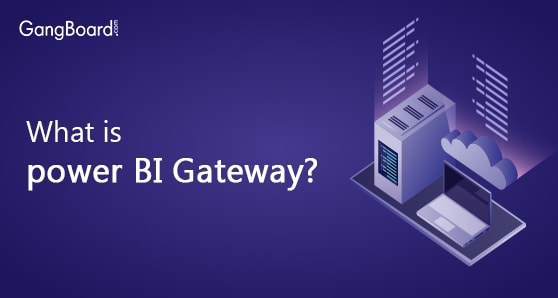
Power BI Gateway
What is Power BI Gateway?
A Power BI Gateway is software developed by Microsoft to access the data on a network; you are required to install the software on the on-premise network. It acts, as the gatekeeper as all requests to the data within the network has to pass through the gateway after meeting certain criteria. This ensures that organizations can keep the data on-premise and use it for Power BI dashboards and reports securely. You can use Power BI Gateways for a single data source or multiple sources.
Types of Power BI Gateway
Power BI offers two types of gateway for two different scenarios:
1. On-premise Information Gateway (One Client)
This type of gateway allows only one user to access the data source and can be connected with Power BI. It is suitable if you are the only person responsible to create the report and there is no requirement to share the data source with others.
2. On-premise Information Gateway (Many Client)
It allows multiple users to connect with the data source with access to build reports. It can be used by applications such as Flow, Power BI, PowerApps, Azure Logic apps, and Azure Analysis Services.
How to use Power BI Gateway?
There are four main steps towards using the Power BI Gateway:
- Install the Power BI Gateway software on the local computer.
- Add users to the Power BI Gateway, so they can access the various sources of data.
- Connect to the data source in order to build dashboards and reports.
- Keep the data up-to-date by refreshing on-premise data.
How Power BI Gateway Works?
After you have installed the gateway, it runs as a Windows service. This service is registered to Gateway Cloud Service through the Azure Service Bus. The below diagram demonstrates the flow of data from on-premise to the cloud services.
How Queries and Data Flow Works:
- A query is generated by any of the cloud services such as Azure Analysis Service, Power BI, PowerApps, or others with encrypted credentials to access the data source.
- After analyzing the query, the Gateway Cloud service passes the request to Azure Service Bus.
- The On-premise Data Gateway receives the queries, decrypts the credentials, and after confirmation of genuinely grants access to the data source.
- On-premise data gateway sends a command to the source for execution.
- The results are then sent back to the cloud service through the same channel it came.
Power BI Gateway Installation Requirements
The gateway acts as an intermediary, providing secure data transfer between the data source and the cloud service. Here, are the system requirements for installing a power BI gateway:
Minimum Requirements:
- .NET 4.6 Framework
- 64-bit version of Windows 7 / Windows Server 2008 R2 (or later)
Recommended:
- 8 Core CPU
- 8 GB Memory
- 64-bit version of Windows 2012 R2 (or later)
Some Other Considerations
- You cannot install the on-premise gateway on a domain controller.
- While using Windows authentication, the gateway should be installed on a system that is on the same Active Directory environment as the data source.
- It is essential that the computer or laptop you are using to install the gateway should never be turned off, sleep, hibernated, or disconnected to the internet. It is also recommended not to use the gateway over a wireless network.
- The gateway is required to be installed on a 64-bit operating system, which should not be a problem as most computers these days are 64-bit or higher.
- Only two gateways can be installed on a single computer where each is running on different types of the gateway.
Power BI Gateway is an essential component of the Power Business Intelligence tool. It facilitates quick and secure data transfer between the cloud services and the data sources, which can be used to build reports and dashboards that can be shared with others within the organization for quick and effective decision-making.


 +1 201-949-7520
+1 201-949-7520 +91-9707 240 250
+91-9707 240 250